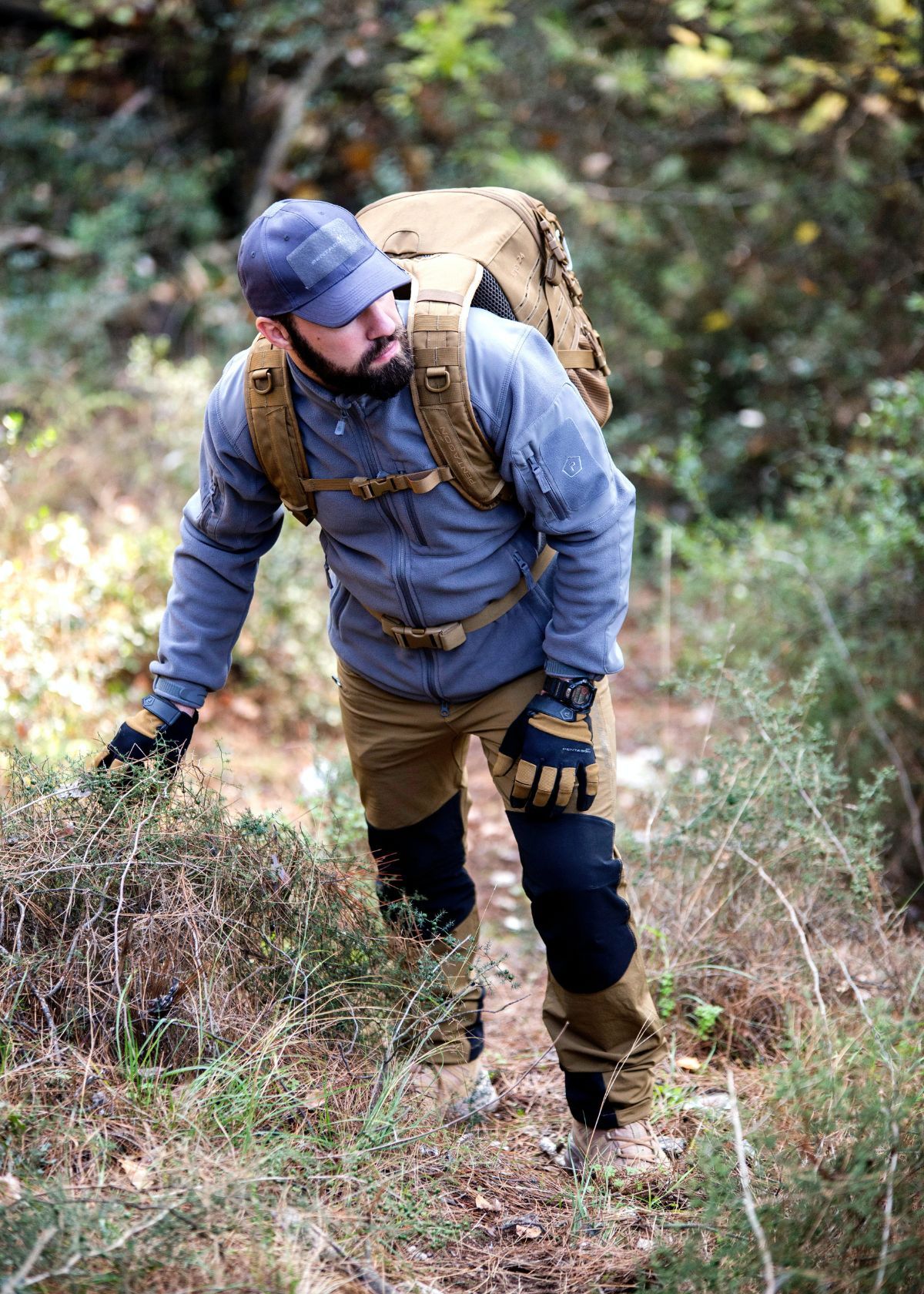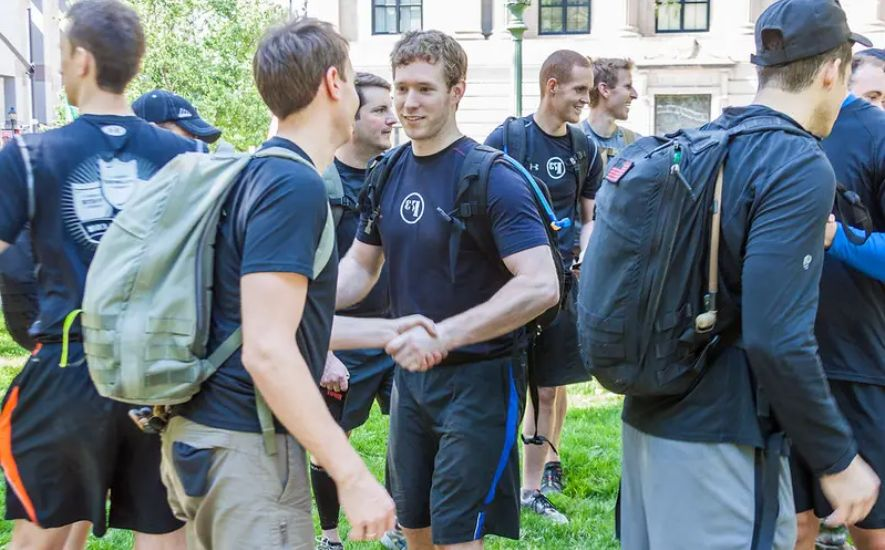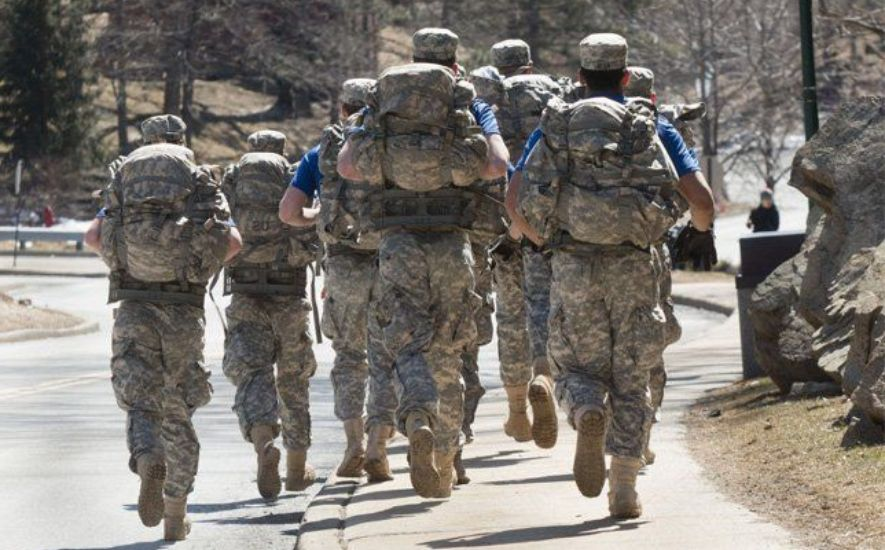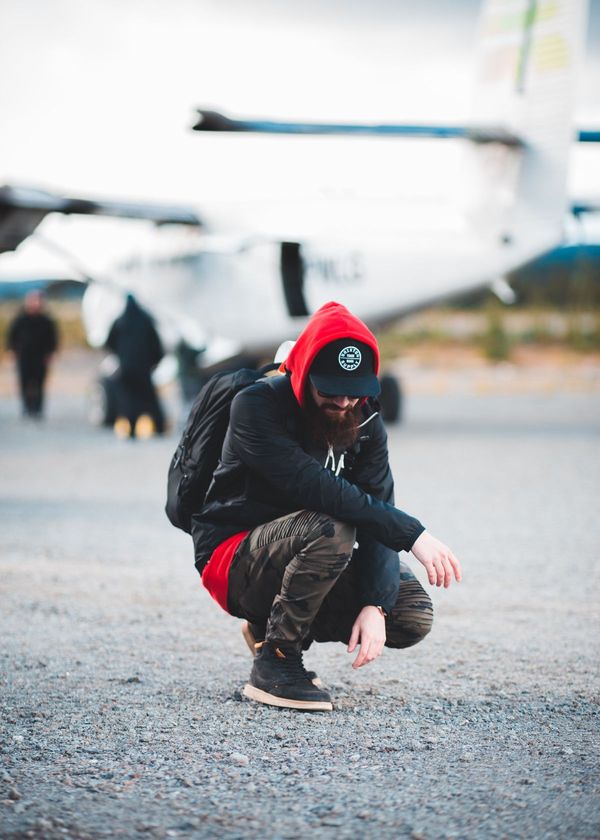In the realm of fitness, there exists a hidden gem, a transformative activity that challenges both mind and body, transcending the conventional boundaries of exercise. Enter the world of rucking: a curious blend of hiking, endurance training, and mental fortitude that beckons adventure seekers and fitness enthusiasts alike.
Imagine embarking on a journey through picturesque landscapes, the weight of a loaded backpack bearing down upon your shoulders, and each step resonating with purpose. Rucking, derived from military training, has captured the imaginations of those yearning for a unique and rewarding path to physical excellence.

But this is no ordinary stroll in the park. Rucking demands preparation, dedication, and a certain audacity to push beyond one's limits. As the saying goes, "Embrace the suck," for rucking is an art form that thrives on discomfort and embraces the transformative power of challenging oneself.
This guide will serve as your compass through the enigmatic realm of rucking, unveiling the secrets of training for this unconventional discipline. From selecting the ideal backpack and gear to building strength, endurance, and mental resilience, we will navigate the intricacies of this extraordinary pursuit.
So, lace up your boots, hoist that pack onto your back, and let us embark on a captivating journey, where ordinary roads transform into trails of discovery and the weight of the world becomes the catalyst for your personal transformation. Get ready to delve into the world of rucking and unveil the boundless potential that lies within you.

Ruck and Roll
In a world where fitness trends come and go, there's one activity that has stood the test of time: rucking. Derived from military training exercises, rucking involves carrying a weighted backpack while walking or hiking.

It's a simple yet effective way to build strength, endurance, and mental fortitude. But why settle for a mundane rucking routine when you can add a touch of creativity and excitement?
The Beat of the Backpack
Rucking is often seen as a solitary activity, but it doesn't have to be. By incorporating music into your rucking routine, you can turn an ordinary trek into a vibrant adventure. Consider creating a playlist that matches your desired pace and energy level.
Whether you're into classic rock, hip-hop, or even EDM, a beat can fuel your rucking workout plan journey. The rhythm of the music will synchronize with your footsteps, giving you a sense of momentum and motivation.
Scenic Rucks and Acoustic Tucks
While music can invigorate your rucking experience, nature provides the perfect minimal heel-toe drop. Instead of sticking to the same old routes, venture out into new territories and explore scenic trails. Immerse yourself in the sights and sounds of nature—the rustling leaves, the babbling brooks, the melodious birdsong.
As you traverse through serene landscapes, let the music guide you, harmonizing with the sounds of nature. It's a symphony that blends the raw beauty of the great outdoors with the captivating melodies that inspire you.
Ruck n' Roll Meets Strength and Soul
Rucking isn't just about endurance; it's also an opportunity to strengthen your body and soul. Along your rucking route, find spots to incorporate body weight vest exercises. Take a break, set down your backpack, and engage in a series of push-ups, lunges, and squats.
Let the music fuel your movements, pushing you to go further and reach new heights. This fusion of rucking workouts and calisthenics will not only improve your physical fitness but also create a deeper connection between mind and body.
Rhythm and Reflection
As you continue your Ruck and Roll adventures, you'll find that rucking becomes more than just a physical challenge. It becomes a form of meditation—a time for introspection and self-reflection.
Use this opportunity to disconnect from the noise of daily life and reconnect with your thoughts and emotions. Allow the rhythm of your steps and the melody of the music to guide your contemplation. It's a chance to gain clarity, find inspiration, and experience moments of profound insight.

Ruck Marches Like a Ninja
Rucking, the art of carrying a loaded backpack, has gained immense popularity in recent years. Not only is it a fantastic workout for building strength and endurance, but it also offers a unique mental challenge.

As rucking enthusiasts seek innovative ways to enhance their training, one approach stands out: rucking like a ninja. Drawing inspiration from the stealthy warriors of ancient Japan, this unconventional training method adds a touch of excitement and creativity to your rucking workout routine.
Embrace the Shadows:
Mastering Stealth and Balance To truly ruck like a ninja, one must develop the art of stealth and balance. Start by incorporating elements of stealth into your training sessions. Choose quiet, wooded trails that mimic the environment where ninjas honed their skills.
Focus on moving silently, being aware of your surroundings, and blending into the natural environment. This mindful approach will not only enhance your rucking experience but also provide an opportunity to connect with nature on a deeper level.
Additionally, balance plays a vital role in ninja-inspired rucking. Consider practicing balance exercises such as single-leg squats, tree pose, or walking on narrow surfaces to improve your stability while carrying a loaded backpack.
Developing a strong sense of balance will not only make your rucking more efficient but also help prevent injuries.
Engage Your Mind:
The Art of Mental Fortitude Ninjas were known for their unwavering mental focus, and adopting a similar mindset can transform your rucking sessions. One way to engage your mind during rucking is through visualization.
Before you embark on your ruck, envision yourself as a stealthy ninja on a mission. Picture the path ahead, anticipate obstacles, and visualize successfully overcoming them. This mental preparation will prime your mind for the challenges that lie ahead, allowing you to push through moments of fatigue and self-doubt.
Another aspect of mental fortitude is embracing discomfort. Ninjas were experts at enduring physical and mental hardships. Train your mind to embrace the discomfort that comes with rucking by setting small goals and pushing beyond your comfort zone. Remember, it is during these challenging moments that your inner ninja truly shines.
Master the Tools:
Incorporating Martial Arts Techniques Ninjas were proficient in various martial arts techniques, and you can infuse your rucking routine with their combat-inspired movements.
Integrate elements of martial arts, such as lunges, kicks, or punches, into your ruck. These dynamic movements not only engage different muscle groups but also inject a sense of excitement and agility into your training. Just make sure to maintain proper form and be mindful of your surroundings to prevent any injuries.
Adaptability and Stealth Training:
The Ninja's Edge Ninjas were known for their ability to adapt to any situation swiftly. To emulate this quality, consider incorporating interval training into your rucking routine.
Alternate between periods of high intensity, where you increase your pace or carry heavier loads, and moments of active recovery, where you slow down or focus on lighter loads.
This adaptability and variety will improve your overall fitness and ensure that you're prepared for any rucking challenge that comes your way.

Rucking Around the World
Have you ever felt the undeniable urge to break free from the monotonous routines of everyday life? To escape the concrete jungle and venture into the great unknown?

If so, then perhaps you've heard the call of the wilderness. There's something primal and exhilarating about immersing oneself in nature, and there's no better way to do it than by rucking.
What is Rucking?
Rucking is the simple act of walking with a loaded backpack. It's a straightforward yet challenging form of exercise that not only strengthens your muscles but also tests your mental endurance.
By strapping on a backpack filled with weights and heading out into the wild, you embark on a journey of self-discovery and physical transformation.
Connecting with Nature and Cultures
Beyond the physical benefits, rucking around the world allows you to forge a deep connection with both nature and different cultures. As you hike through ancient forests, traverse meandering rivers, and ascend majestic peaks, you'll witness the raw beauty of our planet in all its glory.
You'll encounter local communities, learn about their traditions, and perhaps even partake in age-old rituals. The world becomes your classroom, and every step you take becomes a lesson in humility, gratitude, and respect.
Overcoming Challenges and Discovering Inner Strength
Rucking around the world isn't without its challenges. As you navigate treacherous terrains, battle against fatigue, and face unexpected obstacles, you'll discover reservoirs of inner strength you never knew existed.
Every setback becomes an opportunity for growth, and every triumph becomes a testament to your resilience. The journey becomes not only physical but also deeply transformative, shaping you into a stronger, more confident individual.
Ruck the Elements
Rucking, an age-old activity with roots in military training, has gained popularity in recent years as a challenging and effective fitness regimen. It involves carrying a weighted backpack, known as a rucksack while walking or hiking.

The benefits of rucking are numerous, from building strength and endurance to burning calories and improving mental resilience. If you're looking to take your rucking game to the next level, why not consider training in various elements?
Earth:
The Foundation of Rucking The natural terrain of the earth offers a solid foundation for rucking training. Find a local trail, park, or even a beach to embark on your rucking journey.
The uneven surfaces and varying inclines will engage different muscle groups, including your core, as you navigate through rocks, sand, or grass. Embrace the beauty of nature as you immerse yourself in the sights and sounds of the great outdoors.
Fire:
Ignite Your Intensity Adding an element of fire to your rucking training can stoke the intensity and challenge your limits. Incorporate high-intensity interval training (HIIT) exercises during your rucks, such as sprint intervals or burpees.
These bursts of explosive movements will not only elevate your heart rate but also build explosive power and endurance. Feel the fire within as you push yourself to new levels of physical exertion.
Water:
Dive Into Aquatic Rucking Take your rucking to new depths by incorporating water elements. Find a local pool or head to a nearby lake or beach to ruck through the water. The resistance of water adds an extra challenge to your workout, engaging muscles in ways that traditional rucking cannot.
As you maneuver through the water, you'll improve your balance, stability, and overall body strength. Embrace the refreshing sensation of being in the water while training your body and mind.
Ruck & Puzzle: A Mental Challenge
Rucking, a rigorous exercise involving walking or running with a loaded backpack, has gained significant popularity in recent years. It not only strengthens your physical fitness but also tests your mental resilience. To enhance the mental aspect of rucking, an innovative and engaging activity called "Ruck & Puzzle" has emerged.

The Fusion of Rucking and Puzzles:
The idea behind Ruck & Puzzle is to combine the physical intensity of rucking with the mental stimulation of solving puzzles. This fusion creates a unique and multifaceted challenge that pushes participants to their limits.
By engaging both the body and mind simultaneously, Ruck & Puzzle offers a holistic workout experience.
Benefits of Ruck & Puzzle:
a. Mental Stamina: Ruck & Puzzle is an effective way to enhance mental stamina and resilience. The cognitive effort required to solve puzzles while rucking trains your brain to stay focused and sharp, even under physical strain.
b. Problem-Solving Skills: Puzzles come in various forms, such as riddles, crosswords, or even mathematical challenges. By incorporating these puzzles into rucking sessions, participants develop their problem-solving skills and enhance their ability to think critically and creatively.
c. Stress Reduction: Rucking itself is known for its stress-relieving benefits, but when combined with puzzles, it becomes an even more effective stress management tool. The mental engagement provided by the puzzles distracts the mind from everyday worries and promotes relaxation.
d. Improved Memory and Cognitive Function: Studies have shown that mental challenges like puzzles can improve memory retention and overall cognitive function. By integrating puzzles into rucking, participants can enhance their mental acuity and long-term brain health.
How to Engage in Ruck & Puzzle:
a. Choose the Right Puzzle: There are various puzzles to choose from, each offering a unique mental challenge. Opt for puzzles that align with your interests and skill level. Crosswords, brain teasers, or even scavenger hunts can all be adapted to the rucking environment.
b. Start with Short Sessions: If you're new to rucking or puzzles, it's essential to ease into the activity. Begin with shorter sessions to allow your body and mind to adapt gradually. As you build stamina and confidence, you can increase the duration and complexity of your Ruck & Puzzle sessions.
c. Team Challenges: Ruck & Puzzle can be a fantastic team-building exercise. Engage in group rucking sessions where participants work together to solve puzzles. This not only fosters camaraderie but also encourages teamwork and collaboration.
d. Track Your Progress: Keep a record of your rucking distances, puzzle completion times, and the complexity of puzzles you conquer. Tracking your progress will not only motivate you but also allow you to set goals and push your boundaries further.
The Joy of Accomplishment:
The sense of accomplishment derived from completing a challenging rucking session, along with solving complex puzzles, is unparalleled.
Ruck & Puzzle instills a deep sense of satisfaction, boosting self-confidence and fostering a resilient mindset that can be applied to other aspects of life.

Frequently Asked Questions (FAQs)
To help you get started on your rucking journey, we have compiled a list of frequently asked questions (FAQs) regarding training for rucking. Whether you're a beginner looking to incorporate rucking into your fitness routine or an experienced rucker aiming to improve your performance, these FAQs will provide valuable insights and guidance.
How do you get in shape for rucking?
Answer: Getting in shape for rucking requires a well-rounded approach that combines cardiovascular endurance, muscular strength, and overall physical fitness. To start, it's crucial to gradually increase your overall endurance by incorporating regular cardio exercises such as running, cycling, or swimming into your routine. This will help improve your cardiovascular fitness and prepare your body for the demands of rucking.
Additionally, focusing on lower body strength is essential for rucking. Exercises like squats, lunges, and step-ups help develop the muscles in your legs, including the quadriceps, hamstrings, and calves. It's important to gradually increase the weight and intensity of these exercises to build up your muscular endurance.
Core strength is another crucial aspect of rucking. Engaging your core muscles helps stabilize your body and maintain good posture during ruck marches. Incorporate exercises like planks, Russian twists, and mountain climbers to strengthen your abs, obliques, and lower back.
Lastly, don't forget about upper body strength. While rucking primarily targets the lower body, having a strong upper body can help with carrying a loaded backpack for extended periods. Push-ups, pull-ups, and overhead presses are great exercises to include in your routine to strengthen your chest, back, shoulders, and arms.
What muscles do you need for rucking?
Answer: Rucking is a physically demanding activity that engages various muscles throughout your body. While the lower body muscles play a significant role, several other muscle groups are also involved.
First and foremost, the primary muscles used in rucking are located in the lower body. The quadriceps, located in the front of your thighs, are heavily engaged during each step, providing the power to propel you forward. The hamstrings, located at the back of your thighs, work in conjunction with the quadriceps to stabilize and control your leg movements.
Additionally, the glutes, including the gluteus maximus and gluteus medius, are essential for generating power and maintaining stability during long ruck marches. These muscles help extend your hips and stabilize your pelvis, especially when carrying a weighted backpack.
The calf muscles, including the gastrocnemius and soleus, are also heavily involved in rucking. They help propel your kettlebell forward by pushing off the ground and play a crucial role in absorbing the impact of each step.
Apart from the lower body, rucking also engages the core muscles. The abdominal muscles, including the rectus abdominis and obliques, stabilize your torso and maintain proper posture during ruck marches. Strong core muscles are vital for distributing the load evenly and preventing lower back pain or injuries.
What exercises are good for ruck marching?
Answer: To prepare yourself for ruck marching, it's essential to focus on exercises that enhance cardiovascular endurance, lower body strength, core stability, and overall muscular endurance. Here are several exercises that are particularly beneficial for ruck marching:
- Walking and Hiking: These activities serve as a foundation for ruck marching. Start by gradually increasing your walking or hiking distance and speed to build up your cardiovascular endurance.
- Squats: Squats are a fundamental exercise for developing lower body strength. They target the quadriceps, hamstrings, and glutes, which are all heavily engaged during rucking. To make them more specific to ruck marching, you can perform squats while holding a weighted backpack.
- Lunges: Lunges help strengthen the quadriceps, hamstrings, glutes, and calf muscles. Incorporate walking lunges or stationary lunges into your routine to simulate the movements required during ruck marches.
- Step-Ups: Step-ups are excellent for building lower body strength and endurance. Find a stable platform or step and step onto it using one leg at a time. Repeat the movement for a set number of repetitions or time intervals. You can add weight to increase the intensity.
- Planks: Core stability is crucial for maintaining proper posture during ruck marching. Planks engage the entire core, including the abs, obliques, and lower back. Aim for longer plank holds to develop endurance.
How far should I ruck as a beginner?
Answer: As a beginner in rucking, it's important to start with a distance that is manageable and gradually increase it over time. The exact distance will vary based on your current fitness level, but a general guideline for beginners is to start with a ruck march distance of around 1 to 3 miles.
Begin by selecting a shorter distance within this range, and focus on maintaining good form, pace, and posture throughout the ruck march. Pay attention to your body's response and gradually increase the distance as you feel more comfortable and confident.
During your ruck training, listen to your body and be mindful of any signs of fatigue, discomfort, or pain. If you experience excessive fatigue or discomfort during or after a rucksack march, it may be an indication that you pushed too hard or increased the distance too quickly. In such cases, it's important to scale back and allow your body to adapt gradually.
Is it OK to ruck every day?
Answer: Rucking every day can be feasible and beneficial, but it's important to listen to your body and adjust your training accordingly. Rucking is a high-impact activity that places stress on your muscles, joints, and cardiovascular system. Therefore, it's essential to strike a balance between training and recovery.
For beginners or individuals new to rucking, it's generally recommended to have rest days between ruck marches. This allows your body to recover and adapt to the demands of the activity. Starting with two to three ruck marches per week and gradually increasing the frequency as your fitness level improves is a sensible approach.
As you progress and become more accustomed to rucking, you can consider incorporating daily ruck marches into your routine. However, it's important to vary the intensity and duration of your ruck marches to avoid overuse injuries and prevent burnout.
Additionally, it's crucial to prioritize recovery strategies such as proper nutrition, hydration, and adequate sleep. These factors play a significant role in your body's ability to recover and adapt to the physical stress of rucking.
If you do choose to ruck every day, consider implementing different training protocols, such as shorter distance or lower-intensity ruck marches on some days, while reserving longer or more challenging ruck marches for specific training days.
Does rucking build abs?
Answer: Rucking can indirectly contribute to the development of your abdominal muscles, but it is not a primary exercise for targeting or building abs. Rucking primarily engages the muscles of the lower body, including the quadriceps, hamstrings, glutes, and calf muscles.
However, rucking does engage your core muscles to a certain extent. Your core muscles work to stabilize your body and maintain good posture during ruck marches, which indirectly activates your abdominal muscles.
To specifically target and build your abs, it's important to incorporate exercises that directly engage and challenge those muscles. Exercises such as crunches, sit-ups, planks, and Russian twists are more effective for targeting your abdominal muscles and building strength and definition.
While rucking can provide a general workout for your core, it's still recommended to incorporate specific abdominal exercises into your training routine if your goal is to build and strengthen your abs.
Remember that developing visible abs also requires maintaining a low body fat percentage, which is influenced by factors such as diet, overall exercise regimen, and genetics. Therefore, combining a well-rounded training program, including targeted abdominal exercises, with a healthy and balanced diet will yield better results in building and revealing your abdominal muscles.
Conclusion
In conclusion, training for rucking is an art that blends physical endurance with mental resilience. It is a journey that pushes you to new limits, allowing you to explore the depths of your strength and determination. Through disciplined preparation and a progressive approach, one can transform into a formidable rucker.
Rucking is not just about carrying weight on your back; it is about embracing the challenge, conquering the miles, and forging an unbreakable spirit. It teaches you to embrace discomfort and find solace in the rhythm of your footsteps. The path to becoming a proficient Rucker demands consistency, patience, and a willingness to embrace discomfort.
As you lace up your boots and shoulder that heavy pack, remember that each step forward is a testament to your dedication and resilience. The physical and mental gains acquired through rucking extend far beyond the training grounds. They seep into every aspect of your life, empowering you to overcome obstacles, confront adversity, and embrace the beauty of pushing beyond your perceived limits.











